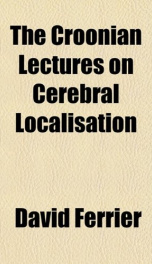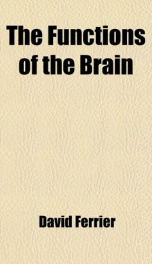the croonian lectures on cerebral localisation

Purchase of this book includes free trial access to www.million-books.com where you can read more than a million books for free. This is an OCR edition with typos. Excerpt from book: LECTURE VI. if K. Pbesident And Gentlemen,I now come to the consideration of the physiological signification of the Rolandic area of the monkey and man, and its homologues in the brain of the lower mammals. I have already described with some detail the movements which are capable of being excited by electrical stimulation of the different regions included within this area. How these movements are to be interpreted is a subject on which there are great differences of opinion. The definite purposive character of the movements, however, their correspondence with the ordinary volitional activities of the animals, and, above all their uniformity and predictability, harmonise best, in my opinion, with the hypothesis that they are indications of the functional excitation of centres directly concerned in effecting volitional movements, and anatomically a part of the motor apparatus. It has been established by experiments on monkeysand now so generally admitted that it is almost unnecessary to enter into detailed proofthat destruction of the centres, excitation of which produces definite movements causes paralysis (qua volition) of the same movements on the opposite side of the body, varying in degree, completeness, and duration with the extent i f the destruction of the respective centres. When the destruction is complete the paralysis is permanent, and is followed in due course by descending degeneration of the pyramidal tracts of the spinal cord, and secondary contracture in the paralysed limbs. As an illustration I quote the fallowing experiment on a monkey which was exhibited at the International Medical Congress in London, 1881, eight months after the operation. The cortex was destroyed as shown in the figure (Fig. 33), in the left hemisphere over an area embracing the as...
Info about the book
Author:
Series:
Unknown
ISBN:
1148031995
Rating:
5/5 (2)Your rating:
0/5
Languge:
English
Users who have this book
Users who want this book
What readers are saying
What do you think? Write your own comment on this book!
write a commentif you like the croonian lectures on cerebral localisation try:
Other books by this author
Do you want to read a book that interests you? It’s EASY!
Create an account and send a request for reading to other users on the Webpage of the book!



